-

人教版高中英语必修2Computers说课稿3篇
一. 教材分析1. 本单元的中心话题是“计算机(Computers)”,内容涉及计算机的发展历史,计算机的应用等。本节课是该单元的第一课时,我将Warming up, Pre-reading and Comprehending这四部分整合为一节精读课。其中。Reading部分是题为WHO AM I?的文章,以第一人称的拟人手法介绍了计算机发长演变的历史和计算机在各个领域的应用,其主旨是表达计算机的发展变化之快以及在生活中用途之广。而Warming up部分以图片的形式展现了计算机的发展历程;Pre-reading中的问题和排序分别是为了预测语篇的内容和测试学生对计算机历史了解的情况;Comprehending则通过各项练习训练学生的阅读技能,从而加深对文章的理解。可见这几部分是一个有机的整体。2. 教学目标:1) 语言目标:重点词汇及短语:abacus, calculate, calculator, PC, laptop, PDA, robot, analytical, technological, universal, mathematical, artificial, intelligent, network, explore, in common, as a result.重点句子:a. My real father was Alan Turing, who in 1963 wrote a book to describe how computers could be made to work, and build a “universal machine” to solve any mathematical problem.

人教版高中英语必修3Astronomy the science of the stars说课稿3篇
Step 2 Pre-listeningAfter students finish their discussion, I will show a picture of Newton and ask them: Who is him? What is he famous for? Could you find out some words to describe him? Maybe students will answer that he is genius for his finding of theGravitation, making a great contribution to the progress of human being. At that time I will show another two pictures of Einstein and Hawking, letting students guess who they are and write down their idea about the Gravitation. For I have arranged them to search more information about the gravity before this class, Students have beenfamiliar with the topic and will not be afraid about this abstract conception, which is helpful for their listening.Step 3 While-listeningIn this step, students will be required to listen the material for three times. The first and listening is extensive listening and the second and third listening is intensive listening. In the first time, They are required to listen a material including Part 1 and Part 2 and choose the best summary of the listening text. After they choose the right answer, They also need work in group to explain what is wrong with the others. Then I will make a conclusion that we should pay attention to the first paragraph and last paragraph and some keys to get the main idea. By doing this, their capacity of generalization will have a great improvement.Before the second listening, I will ask students to scan the blank on the power point quickly and ask them to note down some key words .Then ask them to listen to the Part 1again and fill the first column of the chart. Maybe some students just show the ideas of these three scientists an still can’t catch their development of gravity. Therefore, I will ask them to listen to Part 2 again and fill in the rest. After finish the listening, I will give them ten minutes to discuss with their partner. I will also guidethem to improve their answers when they discuss with others.

人教版高中英语必修2Wildlife Protection说课稿3篇
When it comes to the students’ studying methods, I'd like to introduce my Ss first. The Ss have a good command of basic language points. They’re interested in learning English, and they take an active part in English class, so they will have fun in autonomous, cooperative and inquiry learning. I will just serve as a guide, showing them the way to explore how to make more progress in their English learning.Now it’s time for the most important stage of this lesson. My teaching procedures are arranged as follows:Step1.Leading-in (3 minute)Play a video of a wide variety of wildlife to introduce my topic. Step2. Speaking (12 minutes)We will use our textbook Page25. Let the Ss fast read the short paragraph to warm up. Ask them to talk about the report on some endangered wildlife in China with the dialogue patterns on the screen. Lastly, I will invite some groups to demonstrate their dialogues about saving wildlife in China.Step3.English play (3 minutes)Watch another video in praise of their excellent performance just now. It’s about Jack Chen’s(成龙)and Yang Ziqiong’s wildlife protection.Step4. Listening (twice 13 minutes)This time, I’ll ask the Ss to fill in the blanks of the monologue of the 2 movie stars above. Step5.Discussion (3 minutes)Which would you like to choose to wear, clothes made of cotton, artificial leather or animal skins? Why ?Step6. Summary (3 minutes)1. If there were no wildlife, there wouldn’t exist human beings. If the buying stops, the killing can, too.2. Animals are our friends. To love animals is to love ourselves. Stop hunting, killing and destroying wildlife.3. Let’s live in harmony with all the living things in the world. Step7. Music appreciation (3 minutes)Let the Ss appreciate the song Earth Song by Michael Jackson. Last but not the least, I will show you my blackboard design.

人教版高中英语必修4A taste of English Humor说课稿3篇
Then I would ask them to think of a funny English or Chinese and tell it to partners. While telling stories, they can use expressions and some acting to help make the story funny. 5 minutes would be given to do this.Those stories they told there will be the material for their writing. Soletting them tell it at first is helpful. And they can make a difference between telling a funny story and writing it down. Generally speaking, it is difficult forstudents to write well because they don’t know what to write and how to write. Asking them to tell their own stories at first can help them come up with what to write.After their telling, I would invite someone to share his/her story with all of us and I would write it down on the blackboard.This example story would be used as a sample to illustrate the format of funny story. Different from a story from teacher or textbook, a story from students can obviously become a interesting material to draw students’ attention.Then I would ask the whole class to put this story into several parts. It might be a little bit difficult for them. So I would ask them to find out whether all the sentences are necessary. After delete some sentences, there are 6 sentences left behind. Then they can easily put them into three parts. After interaction with students, I would teach them the right terms for each part and conclude the format of funny story.This step is the key and difficult point in my lesson. So I mainly usetask-based teaching method in this part and the task for students was divided into several stages. With the separated difficult level, students can find there are usually three parts in writing. They can also learn to write without the unnecessary parts in the process of analyzing. And then I wouldn’t rush to tell them the right terms to them directly. Instead, I would ask them to name them by their own. A confused mind is better for acquiring knowledge.While-writing:Then I would give students 7 minutes to write down this story, without other requirements.With all the preparations in pre-writing, students’ difficulties were cleared. So it would be much easier for them to write down the story within 7 minutes. There are no other requirements because students’ first writing is actually a drafting. It would be revise and edit several times later. Writing, as a skill

人教版高中英语必修3Festivals around the World说课稿3篇
Teaching plan for Unit 1 book3Good morning, teachers. It’s my great pleasure to be here because I can share my lesson with you and I can learn a lot from it. I’ll begin my lesson from the following four parts, the teaching material, the teaching methods, the studying methods and the teaching procedure.Firstly, let me talk about the teaching material. The content of my lesson is the reading passage festivals and celebrations of Unit 1 Festivals around the world. This passage is about festivals and celebrations. By studying this passage, we’ll enable the students to know that festivals exit everywhere, and many of festivals in different countries celebrate similar ideas. As we all know, the reading passage is the center of each unit. If the Ss can learn it well, it will be helpful to make the Ss learn the rest of this unit.After studying the teaching material, I think the teaching aims are as the followings:1. Knowledge aims:(1) The Ss can master the usage of the important words andexpressions.(2)The Ss can use the __________________ (grammar) in the proper situation.Make students know about the festivals all over the world and the detail of the festivals, such as origin, content, and the date of the holiday festivals.2. Ability aims:(1) Students can talk about festivals and celebrations in English(2) To improve the student’s reading ability, especially their skimming and scanning ability.3. Emotion aims:Make the Ss know about the foreign festivals, and respect other countries’ custom.Next, let’s come to the important points and the difficult points.The important point is how to make the Ss understand the text better and the difficult point is how can they talk about it. secondly, Teaching Methods:1. task-based Language Teaching2. Computer assisted language teaching.3. question-and–answer methodThirdly, Studying Methods:

人教版高中英语必修4Theme parks说课稿3篇
The oldest and the most popular park in the worldenjoy the exciting activities thereget close to the life-size cartoon characters like Mickey Mouse and Donald Duck Step 3 Pre-reading1.What do you suppose a theme park is ?2.What do you think you can see in a theme park?(1.It is a kind of amusement park which has a certain theme – that the whole park is based on. 2.buildings, castles, statues, rare animals and birds, and so on.) Step 4 Reading ----- Theme Parks –---- Fun and More Than Fun1.Predict : Read the title and the pictures on P. 34 and PredictWhat is the meaning of the title “Theme Park – Fun and more than fun”?(The title means that theme parks are fun to visit, but that they can also be educational and can offer useful information.)2.Skimming Fast read and answer:What activities can we take in a theme park?Amusement park: Bumper car Merry-go-round slide bungee jumping Free-fall rides Horror films Pirate ship Ferris wheel roller coaster3.Scanning Read again and you will find various theme parks are mentioned in the passage . Then what are they ?Theme parks: Sports theme park History theme park Culture theme park Marine or Ocean theme Park Future park Science theme park Disneyland4.Careful reading and find the main idea of each paragraph:THEME PARKS---- entertaining/ educationalPara.1 Traditional parks are places to go for relaxation and to have time away from our busy lives.Para.2 Theme parks are different They’re large and full of things to do, see and buy.Para.3 Theme parks are built around a single idea or theme. One example is a sports park.Para.4 Another kind of theme park is historical more and cultural and can be educational.Para.5 Disneylandwas the first theme park. It is based on the fantasy life and characters of Disney’s films.Para.6 Some examples of educational theme parks include sea world parks and science parks.

人教版高中英语必修3Healthy Eating说课稿4篇
Language learning needs a context, which can help the learners to understand the language and then can product comprehensible output, so computer has the advantages to make the materials attractive.Part 3 Learning MethodsTask-based, self-dependent and cooperative learningPart 4 Teaching ProcedureStep One Lead-in“Interest is the best teacher.” Therefore, at the very beginning of the class, I should spark the students’ mind to focus on the centre topic “the band”. I’ll show some pictures of food to attract their attention and then bring some questions.Question:What kind of food they like?What should go into a good meal?The answers must relate to the diet. After this, the students will be eager to know something about a balance diet and this is the very time to naturally lead the class into Step 2Step 2 Reading for information: skimming and scanning In this step, I use Task-based Language Teaching method, which can give students a clear and specific purpose while skimming and scanning the context.Task 1 General ideaThe students will be asked to just glance at the title and the pictures of the passage, and then guess what they will read in the text. And they’ll be divided into groups of four to have a discussion.The purpose is to inspire the students to read actively, not passively. In addition, the task is to develop the students’ reading skill by making prediction and to encourage the students to express their thoughts in English and cooperate with each other.Task 2 Main idea of each paragraphCooperative learning can raise the students’ interest and create an atmosphere of achievement. Based on this theory, I divide the whole class into 4 groups to skim the whole text and get the main idea of each paragraph.

人教版高中英语必修5First aid说课稿6篇
In this class, I have 3 teaching aims, that is, knowledge aims, ability aims and emotion aims.1) Knowledge-Teach students new words and expressions, such as temporary, bleed,sprain choke, first aid, fall ill and so on.-Enable students to have a better understanding for some basic knowledge of first aid.2) Ability-Train students’ speaking, reading and writing abilities by different teaching activities, such as skimming, comprehending, team work, role play, retelling and writing.-Develop students’ reading strategy on how to move general idea to specific information.3) Emotion-Promote students’ awareness of giving first aid.- Cultivate students’ creativities.Then let’s come to my teaching methods and activities.III. Teaching methods and activities:To achieve different teaching aims, various kinds of teaching methods and activities will be adopted throughout this period, such as TBL (task-based learning), skimming, team work, brainstorm and others, which can offer students opportunities to fulfill tasks in which they can use language to achieve a specific outcome.IV. Teaching aids:Computer and blackboardV. Teaching important points:1) Make students have a clear mind for the structure of the text.2) Help students understand the theme of the text.VI. Teaching difficulties:1) So many new words may affect students’ understanding.2) How to get students to know about the functions of the skin and thecauses, characteristics and treatments for different degree burns,and the knowledge about giving first aid. VII. Blackboard design:

人教版高中英语必修5Great scientists说课稿4篇
通过写文章梗概,培养学生综合运用语言的能力,学习用恰当的英语描述科学家的故事。这是本课的教学难点。教师可以使用完形填空的方式来帮助学生整理语篇,从而来降低难度。本课的教学重点的突破方法是:在阅读前,让学生初步了解得出科学观点所需要的基本程序,从而轻松而自然地导入文章的阅读;在阅读过程中,由易到难设计快速阅读和精读的问题,层层推进各种阅读活动,让学生对阅读内容从整体感知到细节理解,最后深层读懂整篇文章,同时加强阅读策略的指导,让每个学生都主动参与课堂教学活动,最终达到提高阅读能力的目的。Step 4 Post-readingGroup Activities四人小组共同合作,在老师的适当指导下,就以下2个问题展开讨论,让学生就所知、所学、所感和所想融入话题,然后抽若干同学代表作小组发言。1. What do you think about John Snow, and what should we learn from him?2. Cholera was 19th century disease, which two diseases are similar to cholera today? Why?

人教版高中英语必修5Life in the Future说课稿5篇
Good afternoon, everyone. It’s my great pleasure to be here sharing my lesson with you. The content of my lesson is Senior English for China Book5 Unit 3 Life in the Future. I’ll be ready to begin this lesson from six parts: Analysis of the teaching material, Analysis of the students, Teaching aims and important and difficult points, Teaching methods and aids, Teaching procedures, and Blackboard design. First, let me talk about the teaching material.Part 1 Analysis of the Teaching Material:This unit is about what human beings’ life will be like in about one thousand years. By studying of this unit, we’ll Enable the students to know the changes in humans’ life and some new inventions bringing about the change and develop the interest in science. This lesson plays an important part in the English teaching in this unit. This is an important lesson in Book Five. From this lesson, it starts asking the Ss to grasp contents of each passage. Therefore, this lesson is in the important position of the teaching material. If the Ss can learn it well, it will be helpful to make the Ss learn the rest of this unit.Part 2 Analysis of the SsAs Senior2 Ss, they are at different levels of English fluency, some of them have lost interest in English. So during the lesson, I arrange a variety of activities to let all of them join in to attract their interest and let them be confident and taste the joy of success.
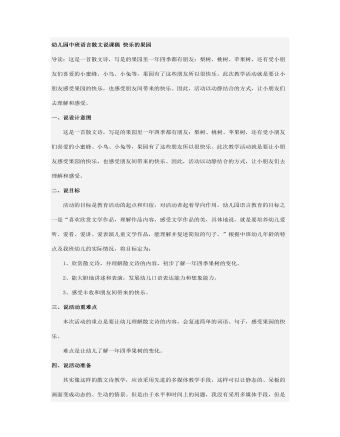
幼儿园中班语言散文说课稿 快乐的果园
(一)、开始部分 首先,我播放《快乐小舞曲》,带领幼儿一起进入果园当中,小朋友们其乐融融,能够快快乐乐地进入活动场地开始活动。其次,我让幼儿说说果园里有什么,引导幼儿以观察的方式回答老师的提问。之后,我手指幼儿面前的三棵果树,让他们猜猜这三棵果树是什么树,引导幼儿以想象的方式回答。 (二)、基础部分 这一部分正式进入散文诗欣赏,我先读一遍,幼儿欣赏,理解大概内容,然后我提出一系列有关果树的问题,引导幼儿以听的方式来回答,并鼓励他们大胆讲述。 这一部分,让幼儿边理解边感受散文诗的意境美,从而让他们知道白白的是梨花,粉色的是桃花,红红的是苹果花,黄澄澄的是大梨,粉粉的是桃子,红红的是大苹果,通过幼儿自由讲述和老师的适当提示,让他们初步了解一年四季果树的变化。 以上都是静态教学,然后我讲述散文诗第二遍,让幼儿说说有哪些小动物,他们在干什么。根据他们的回答,我发给他们头饰,让他们表演,培养他们大胆的表演能力。最后提到的采摘丰收果实的人们也是让幼儿表演采果实,体验丰收的快乐。这些是动态教学。 教学中动静结合,可激发幼儿的兴趣,也可让活动开展地生动、丰富。
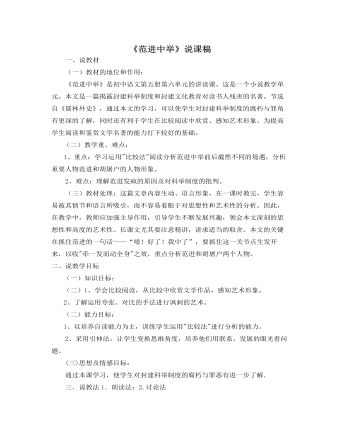
部编版语文九年级上册《范进中举》说课稿
一、说教材(一)教材的地位和作用:《范进中举》是初中语文第五册第六单元的讲读课。这是一个小说教学单元。本文是一篇揭露封建科举制度和封建文化教育对读书人残害的名著。节选自《儒林外史》,通过本文的学习,可以使学生对封建科举制度的腐朽与罪角有更深的了解,同时还有利于学生在比较阅读中欣赏、感知艺术形象。为提高学生阅读和鉴赏文学名著的能力打下较好的基础。(二)教学重、难点:1、重点:学习运用"比较法"阅读分析范进中举前后截然不同的境遇,分析重要人物范进和胡屠户的人物形象。2、难点:理解范进发疯的原因及对科举制度的批判。(三)教材处理:这篇文章内容生动、语言形象,在一课时教完,学生容易被其情节和语言所吸引,而不容易着眼于对思想性和艺术性的分析。因此,在教学中,教师应加强主导作用,引导学生不断发展兴趣,领会本文深刻的思想性和高度的艺术性。长课文尤其要注意精讲,讲求适当的取舍。
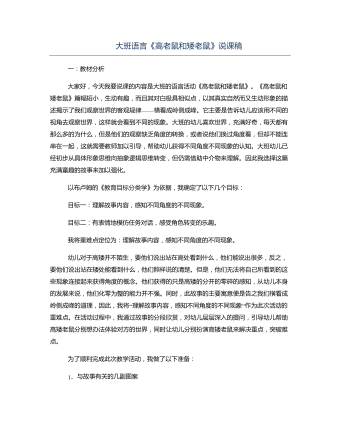
大班语言《高老鼠和矮老鼠》说课稿
以布卢姆的《教育目标分类学》为依据,我确定了以下几个目标:目标一:理解故事内容,感知不同角度的不同现象。目标二:有表情地模仿任务对话,感受角色转变的乐趣。我将重难点定位为:理解故事内容,感知不同角度的不同现象。幼儿对于高矮并不陌生,要他们说出站在高处看到什么,他们能说出很多,反之,要他们说出站在矮处能看到什么,他们照样说的清楚。但是,他们无法将自己所看到的这些现象连接起来获得角度的概念。他们获得的只是高矮的分开的零碎的感知,从幼儿本身的发展来说,他们化零为整的能力并不强。同时,此故事的主要寓意便是告之我们横看成岭侧成峰的道理,因此,我将“理解故事内容,感知不同角度的不同现象”作为此次活动的重难点。在活动过程中,我通过故事的分段欣赏,对幼儿层层深入的提问,引导幼儿帮助高矮老鼠分别想办法体验对方的世界,同时让幼儿分别扮演高矮老鼠来解决重点,突破难点。为了顺利完成此次教学活动,我做了以下准备:1、与故事有关的几副图案2、高老鼠和矮老鼠的图饰二:说教法纲要中指出:教师应成为幼儿学习活动的支持者、合作者和引导者,在活动过程中应力求形成合作探究式的师幼互动。因此,我采用了游戏法、分段讲述法、提问法等几种教学方法。1、游戏法:纲要指出:应寓教育于生活、游戏之中,使幼儿能在学中玩、玩中学、玩中求发展。在活动的第一环节,我采取了让幼儿游戏的方法,使之初步感受高矮。2、分段讲述法:讲述法是语言活动的基本方法之一,在活动过程中,讲述时我注意到声音的抑扬顿挫,语调的高低,语气的变化来引起幼儿的兴趣。同时采用分段讲述是帮助幼儿更好地理解故事内容,层层深入的思考获得高矮的概念。3、提问法:提问法是指教师利用各种手段激发幼儿积极思维的方法。在活动过程中我通过提问描述性的问题“高老鼠看到了什么”“矮老鼠看到什么”,思考性问题“还会看到什么”等来帮助幼儿加深对故事的理解,同时我注意到请不同层次的幼儿进行作答,充分体现了纲要中的“满足群体需要和尊重个体差异,使每个幼儿都能获得成功的满足感”。
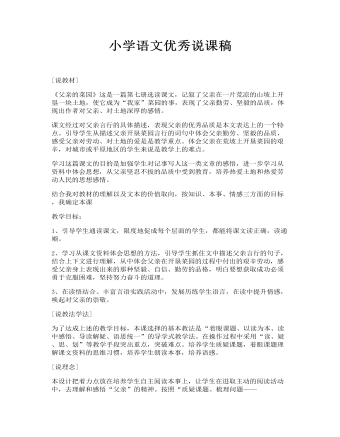
小学语文优秀说课稿 (优选10篇)
教学目标:1、引导学生通读课文,限度地促成每个层面的学生,都能将课文读正确,读通顺。2、学习从课文资料体会思想的方法,引导学生抓住文中描述父亲言行的句子,结合上下文进行理解,从中体会父亲在开垦菜园的过程中付出的艰辛劳动,感受父亲身上表现出来的那种坚毅、自信、勤劳的品格,明白要想获取成功必须勇于克服困难,坚持努力奋斗的道理。3、在读悟结合、丰富言语实践活动中,发展历练学生语言,在读中提升情感,唤起对父亲的崇敬。[说教法学法]为了达成上述的教学目标,本课选择的基本教法是“着眼课题、以读为本、读中感悟、导读解疑、语思统一”的导学式教学法。在操作过程中采用“读、疑、思、划”等教学手段突出重点,突破难点。培养学生质疑课题,着眼课题理解课文资料的思维习惯,培养学生朗读本事,培养语感。
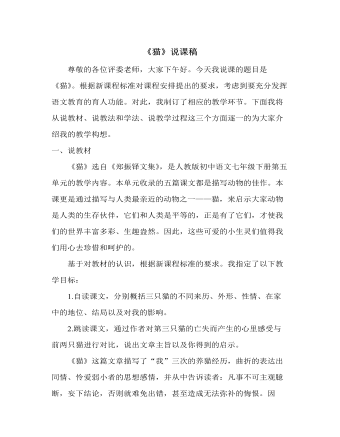
部编版语文七年级上册《猫》说课稿
一、说教材《猫》选自《郑振铎文集》,是人教版初中语文七年级下册第五单元的教学内容。本单元收录的五篇课文都是描写动物的佳作。本课更是通过描写与人类最亲近的动物之一——猫,来启示大家动物是人类的生存伙伴,它们和人类是平等的,正是有了它们,才使我们的世界丰富多彩、生趣盎然。因此,这些可爱的小生灵们值得我们用心去珍惜和呵护的。基于对教材的认识,根据新课程标准的要求。我指定了以下教学目标:1.自读课文,分别概括三只猫的不同来历、外形、性情、在家中的地位、结局以及对我的影响。2.跳读课文,通过作者对第三只猫的亡失而产生的心里感受与前两只猫进行对比,说出文章主旨以及你得到的启示。《猫》这篇文章描写了“我”三次的养猫经历,曲折的表达出同情、怜爱弱小者的思想感情,并从中告诉读者:凡事不可主观臆断,妄下结论,否则就难免出错,甚至造成无法弥补的悔恨。因此,我将教学目标的第一点:概括三只猫的不同来历、外形、性情、在家中的地位、结局以及对我的影响作为本课的教学重点。而说出文章主旨以及得到的启示作为本课教学难点。
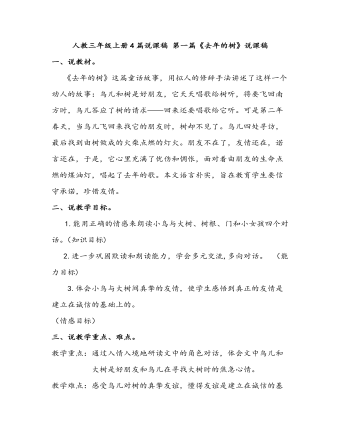
人教版三年级上册语文说课稿
二、说教学目标。 1.能用正确的情感来朗读小鸟与大树、树根、门和小女孩四个对话。(知识目标) 2.进一步巩固默读和朗读能力,学会多元交流,多向对话。 (能力目标) 3.体会小鸟与大树间真挚的友情,使学生感悟到真正的友情是建立在诚信的基础上的。
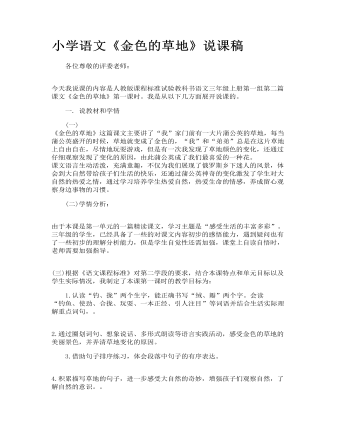
小学语文《金色的草地》说课稿
(二)学情分析: 由于本课是第一单元的一篇精读课文,学习主题是“感受生活的丰富多彩”。三年级的学生,已经具备了一些的对课文内容初步的感悟能力,遇到疑问也有了一些初步的理解分析能力,但是学生自觉性还需加强,课堂上自读自悟时,老师需要加强指导。 (三)根据《语文课程标准》对第二学段的要求,结合本课特点和单元目标以及学生实际情况,我制定了本课第一课时的教学目标为: 1.认读“钓、拢”两个生字,能正确书写“绒、瓣”两个字。会读 “钓鱼、使劲、合拢、玩耍、一本正经、引人注目”等词语并结合生活实际理解重点词句,。 2.通过圈划词句、想象说话、多形式朗读等语言实践活动,感受金色的草地的美丽景色,并弄清草地变化的原因。 3.借助句子排序练习,体会段落中句子的有序表达。 4.积累描写草地的句子,进一步感受大自然的奇妙,增强孩子们观察自然,了解自然的意识。。
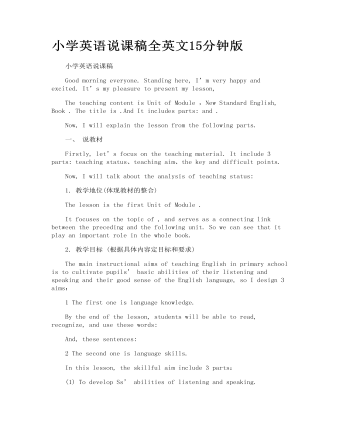
小学英语说课稿全英文15分钟版
一、 说教材 Firstly, let’s focus on theteaching material. It include 3 parts: teaching status、teachingaim、the key and difficult points. Now, I will talk about the analysis of teaching status: 1. 教学地位(体现教材的整合) The lesson is the first Unit of Module . It focuses on the topic of , and serves as a connectinglink between the preceding and the following unit. So we can see that it playan important role in the whole book. 2. 教学目标 (根据具体内容定目标和要求) The main instructional aims of teaching English inprimary school is to cultivate pupils’ basic abilitiesof their listening and speaking and their good sense of the English language,so I design 3 aims:
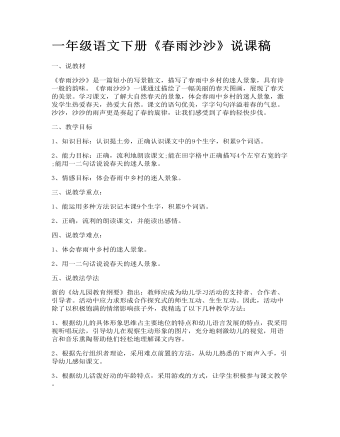
一年级语文下册《春雨沙沙》说课稿
二、教学目标1、知识目标:认识提土旁,正确认识课文中的9个生字,积累9个词语。2、能力目标:正确,流利地朗读课文;能在田字格中正确描写4个左窄右宽的字;能用一二句话说说春天的迷人景象。3、情感目标:体会春雨中乡村的迷人景象。三、说教学重点:1、能运用多种方法识记本课9个生字,积累9个词语。2、正确,流利的朗读课文,并能读出感情。四、说教学难点:1、体会春雨中乡村的迷人景象。2、用一二句话说说春天的迷人景象。五、说教法学法新的《幼儿园教育纲要》指出:教师应成为幼儿学习活动的支持者、合作者、引导者。活动中应力求形成合作探究式的师生互动、生生互动。因此,活动中除了以积极饱满的情绪影响孩子外,我精选了以下几种教学方法:1、根据幼儿的具体形象思维占主要地位的特点和幼儿语言发展的特点,我采用视听唱玩法,引导幼儿在观察生动形象的图片,充分地刺激幼儿的视觉,用语言和音乐熏陶帮助他们轻松地理解课文内容。
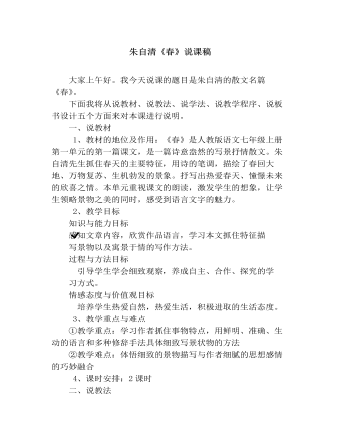
部编版语文七年级上册《春》说课稿
一、说教材1、教材的地位及作用:《春》是人教版语文七年级上册第一单元的第一篇课文,是一篇诗意盎然的写景抒情散文。朱自清先生抓住春天的主要特征,用诗的笔调,描绘了春回大地、万物复苏、生机勃发的景象。抒写出热爱春天、憧憬未来的欣喜之情。本单元重视课文的朗读,激发学生的想象,让学生领略景物之美的同时,感受到语言文字的魅力。2、教学目标知识与能力目标 感知文章内容,欣赏作品语言,学习本文抓住特征描写景物以及寓景于情的写作方法。过程与方法目标引导学生学会细致观察,养成自主、合作、探究的学习方式。情感态度与价值观目标培养学生热爱自然,热爱生活,积极进取的生活态度。3、教学重点与难点 ①教学重点:学习作者抓住事物特点,用鲜明、准确、生动的语言和多种修辞手法具体细致写景状物的方法②教学难点:体悟细致的景物描写与作者细腻的思想感情的巧妙融合